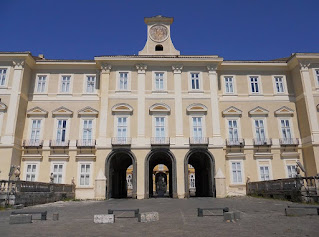La Pietà - Michelangelo's masterpiece
Brilliant sculpture commissioned by French Cardinal
Michelangelo Buonarotti agreed the contract to create the sculpture that would come to be regarded as his masterpiece on this day in 1498. It was made between the artist and Cardinal Jean de Bilhères-Lagraulas, the French ambassador to the Holy See, who wanted a sculpture of the Virgin Mary grieving over the body of Jesus, which was a common theme in religious art in northern Europe at the time. Michelangelo, who would live until he was almost 89, was just 23 at the time and had been in Rome only a couple of years, but was about to produce a piece of work that astounded his contemporaries and is still seen as one of the finest pieces of sculpture ever crafted. La Pietà – in English, 'the pity' – was carved from a block of blue and white Carrara marble selected by Michelangelo, a good six feet (183cm) tall by six feet across. The Cardinal intended it to be his funeral monument. It was eventually placed in a chapel in St Peter’s Basilica. The work shows the body of Christ, shortly after being taken down from the cross following his crucifixion by the Romans, cradled in the lap of Mary. It is necessarily out of proportion – Michelangelo makes Mary quite a broad figure to accommodate the body of a man lying across her - but the detail is exquisite. Read more…
________________________________________
Carlo Camillo Di Rudio - soldier
Italian aristocrat who survived Battle of the Little Bighorn
Carlo Camillo Di Rudio, a military officer who became known as Charles Camillus DeRudio and gave 32 years’ service to the United States Army in the late 19th century, was born in Belluno in northern Italy on this day in 1832. Having arrived in New York City as an immigrant from England in 1860, he served as a volunteer in the American Civil War (1861-65) before joining the Regular Army in 1867 as a 2nd lieutenant in the 2nd Infantry, an appointment which was cancelled when he failed a medical. Undeterred, he was readmitted and joined the 7th Cavalry in 1869, eventually attaining the rank of Major. He participated in the Battle of the Little Bighorn, in which the US Army suffered a defeat to the combined forces of Lakota, Northern Cheyenne, and Arapaho tribesmen. The battle was part of the Great Sioux Wars of 1876, fought for possession of the Black Hills in South Dakota, where gold had been found. DeRudio was thrown from his horse as the American forces under Major Marcus Reno were driven back across the Little Bighorn River to regroup on the eastern side. He was left stranded on the western side and hid for 36 hours with a private, Thomas O’Neill. Read more…
_____________________________________
Sant’Alessandro of Bergamo
Annual festival keeps alive the memory of city’s saint
The patron saint of Bergamo, Sant’Alessandro, was martyred on this day in 303 by the Romans for refusing to renounce his Christian faith. It is believed Alessandro was a devout citizen who had continued to preach in Bergamo, despite having several narrow escapes from would-be Roman executioners, but he was eventually caught and suffered public decapitation. In Christian legend, Alessandro was a centurion of the Theban Legion, a legion of the Roman army that converted en masse to Christianity, whose existence prompted a crusade against Christianity launched by the Romans in around AD 298. Alessandro was reputedly held in prison in Milan on two occasions but escaped to Bergamo, where he defiantly refused to go into hiding and instead openly preached, converting many Bergamaschi to his faith. Of course, he was ultimately taken into custody again by the Romans and beheaded on August 26, 303, on the spot now occupied by the church of Sant' Alessandro in Colonna in Bergamo’s Città Bassa (lower town). Today is the Festa di Sant'Alessandro. Read more…
____________________________________
Book of the Day: Michelangelo: His Life and Works in 500 Images, by Rosalind Ormiston
The first half of the stunning Michelangelo: His Life and Works in 500 Images explores Michelangelo's fascinating life through his family, friends, patrons and commissions. Born near Florence in 1475 Michelangelo grew up surrounded by new forms of architecture, painting and sculpture. His influences and achievements are explained clearly and comprehensively with informative and attractive illustrations throughout. The second half of the book contains a comprehensive gallery of over 300 of his major works of sculpture, painting and architecture. These superb reproductions are accompanied by thorough analysis of each artwork and its significance with the context of Michelangelo's life, his technique and his body of work as a whole.Rosalind Ormiston is a researcher, lecturer and author with a wide range of interests in art, architecture and design history. Since 2002 she has been a lecturer in art and architectural history at Kingston University, London with a specialist field of Renaissance Italy.
Booking.com.jpg)

.jpg)



.jpg)




_-_Archivio_Storico_Ricordi_FOTO000539.jpg)




.jpg)




.jpg)
.jpg)
.jpg)

.jpg)





.jpg)
.jpg)
.jpg)
